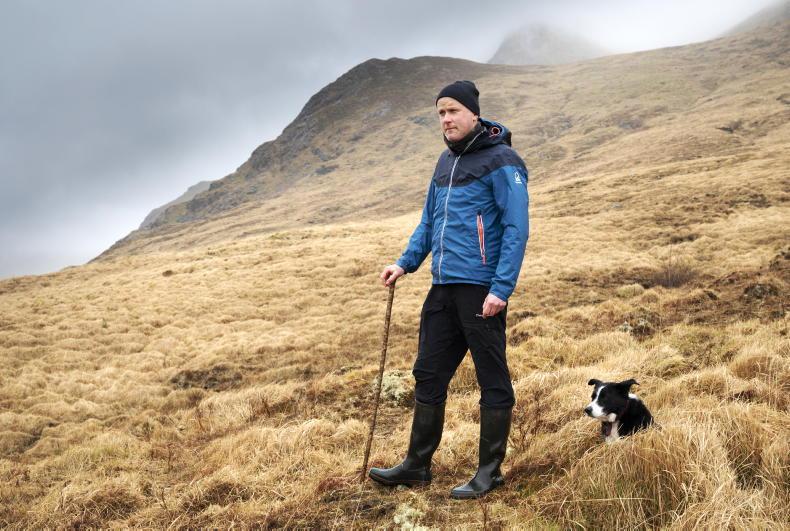I farm: “A mixture of commonage and privately owned land. There is about 110ha in total. The commonage is shared between myself, my father, my brother and my neighbour.”
Ewes: “We have 120 Mayo Blackface breeding ewes and run them with a Blackface ram. We have a few bullocks as well for conservational grazing as the Molinia can take over a bit. The sheep wouldn’t be able to keep that grass in check by themselves.”

\ Michael McLaughlin
Lambing: “We are coming up on lambing here now at the moment. We plan to start around 18 April every year. We wouldn’t have grass around here until that time of year you see.”
Mart: “We usually go to the mart with our lambs but, last year, we took a few to the factory. Some farmers buy them from us privately as stores and fatten them.”
Seaweed: “I usually spread a small bit of fertiliser but this year I’m going to make use of seaweed as we live right beside the sea. We harvested it by hand and it’s fermenting at the moment. It’s the water we will use – I’ll dilute it and spread it in about two weeks’ time. It’s a bit of a trial but we plan to buy a bit more meal if needs be and hopefully together with the seaweed it will offset not buying any fertiliser.”
Pearl Mussel Project: “We are farming in a very sensitive spot here, it’s a Special Area of Conservation (SAC). We are the only producer of juvenile pearl mussel in Europe. Given the amount of rain we get in these parts we have to be mindful of our watercourses when we are farming.”

\ Michael McLaughlin
Rhododendron: “We are also in a rhododendron removal project and are learning how best to manage rhododendron. Actively farming the land is probably the most important thing to keep it at bay.”

\ Michael McLaughlin
Quotable quote: “Having a good relationship with your neighbours and community is a vital part of farming in the uplands.”
I farm: “A mixture of commonage and privately owned land. There is about 110ha in total. The commonage is shared between myself, my father, my brother and my neighbour.”
Ewes: “We have 120 Mayo Blackface breeding ewes and run them with a Blackface ram. We have a few bullocks as well for conservational grazing as the Molinia can take over a bit. The sheep wouldn’t be able to keep that grass in check by themselves.”

\ Michael McLaughlin
Lambing: “We are coming up on lambing here now at the moment. We plan to start around 18 April every year. We wouldn’t have grass around here until that time of year you see.”
Mart: “We usually go to the mart with our lambs but, last year, we took a few to the factory. Some farmers buy them from us privately as stores and fatten them.”
Seaweed: “I usually spread a small bit of fertiliser but this year I’m going to make use of seaweed as we live right beside the sea. We harvested it by hand and it’s fermenting at the moment. It’s the water we will use – I’ll dilute it and spread it in about two weeks’ time. It’s a bit of a trial but we plan to buy a bit more meal if needs be and hopefully together with the seaweed it will offset not buying any fertiliser.”
Pearl Mussel Project: “We are farming in a very sensitive spot here, it’s a Special Area of Conservation (SAC). We are the only producer of juvenile pearl mussel in Europe. Given the amount of rain we get in these parts we have to be mindful of our watercourses when we are farming.”

\ Michael McLaughlin
Rhododendron: “We are also in a rhododendron removal project and are learning how best to manage rhododendron. Actively farming the land is probably the most important thing to keep it at bay.”

\ Michael McLaughlin
Quotable quote: “Having a good relationship with your neighbours and community is a vital part of farming in the uplands.”









 This is a subscriber-only article
This is a subscriber-only article











SHARING OPTIONS: